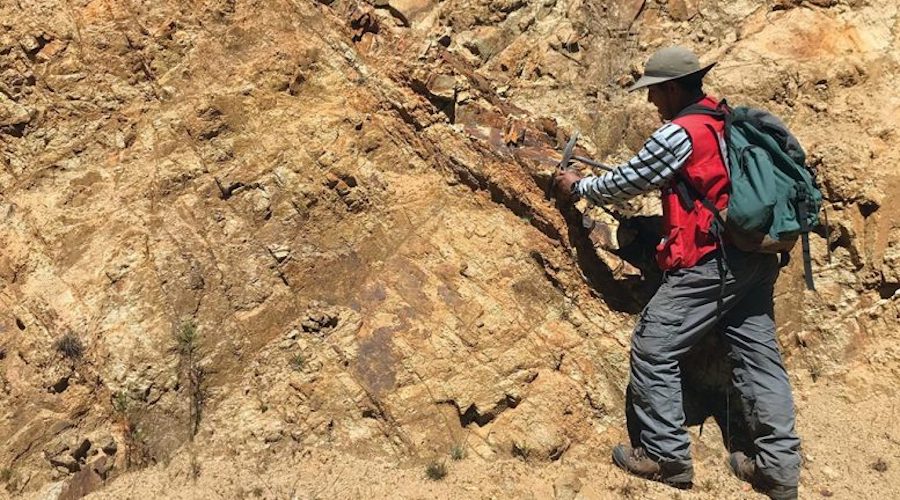
Compelling supply and demand projections for copper in the years ahead makes the red metal one of the favourites of industry observers, who see flat-lining mine supply running into increased demand as the world continues to achieve greater electrification. Here’s a look at eight active juniors with substantial copper assets in their property portfolios.
AURYN RESOURCES
While Vancouver-based junior Auryn Resources (TSX: AUG; NYSE-AM: AUG) is primarily a gold explorer with its flagship Committee Bay gold project in Nunavut, it does have a large copper-gold porphyry project in its portfolio in the form of the 1,200 sq. km Sombrero copper-gold property, located 340 km southeast of Lima in southern Peru at a 3,900-metre elevation, with road and power access.
The property is located in the Andahuaylas-Yauri geological belt, and Auryn interprets it to be on the northwestern margin of the Eocene–Oligocene-aged copper-gold porphyry and skarn belt that hosts the Las Bambas, Haquira, Los Chancas, Cotambambas, Constancia, Antapaccay and Tintaya deposits.
Auryn’s principal target at Sombrero is copper-gold skarn mineralization, which the company says has “geological similarities to the Tintaya and Las Bambas mines,” though it says samples being collected at Sombrero are copper-gold, rather than molybdenum-gold. In addition, Auryn notes a layer of volcanic cover that is between 5 to 25 metres thick at Sombrero, which is not seen farther east where the Los Chancas, Las Bambas and Tintaya mines are located.
The first trench of Auryn’s 2019 program at Sombrero was Trench 20 in the Fierrazo concession, and it has delivered 232 metres of 0.55% copper equivalent (0.47% copper and 0.13 gram gold per tonne), including 40 metres of 1.26% copper equivalent (1.23% copper and 0.05 gram gold).
Auryn acquired the rights to the Sombrero property through an option agreement with Alturas Minerals, whereby to exercise the option and acquire a participating interest for 80% of the Sombrero concessions, Auryn must incur up to US$2.1 million in work expenses within five years, and make cash payments of $200,000.
CAMINO MINERALS

A drill site on Camino Minerals’ Los Chapitos copper project in Peru. Photo by Camino Minerals.
Edmonton-based explorer Camino Minerals (TSXV: COR; US-OTC: CAMZF) was spun out of Canplats Resources in 2010 after its $300-million acquisition by Goldcorp, which wanted Canplats’ 4 million oz. gold Camino Rojo gold-silver discovery in Mexico.
Today, Camino is led by president and CEO John Williamson and is focused on copper and gold projects in Peru, though it also has assets in Mexico, the U.S. and Canada.
In Peru, its flagship asset is its Los Chapitos copper-gold project, which covers 200 sq. km near Chala in the country’s southern region.
In March, Camino reported its newest discovery at Los Chapitos named the Lidia Zone, which spans 3 by 4 km, and is located 5 km northwest of the main Adriana copper zone.
Camino says Lidia “adds an entirely new type of exploration target to the property comprising a large area of copper and gold anomalism, which is extremely interesting.”
Camino has collected 238 rock samples in the Lidia area, and comments that “although somewhat selective in nature, [they] collectively average 0.20 gram gold per tonne and 0.75% copper, with individual samples returning values of up to 11.1 grams gold and 23.4% copper.” This mineralization is hosted within stockwork quartz veins, some of which are associated with zones of shearing and brecciation within the host monzonite.
This year’s exploration program at Los Chapitos will further examine the Lidia zone and identify possible drill targets for a drill program. The work will include geological mapping, channel and or trench sampling, and geophysical surveying.
CARUBE COPPER
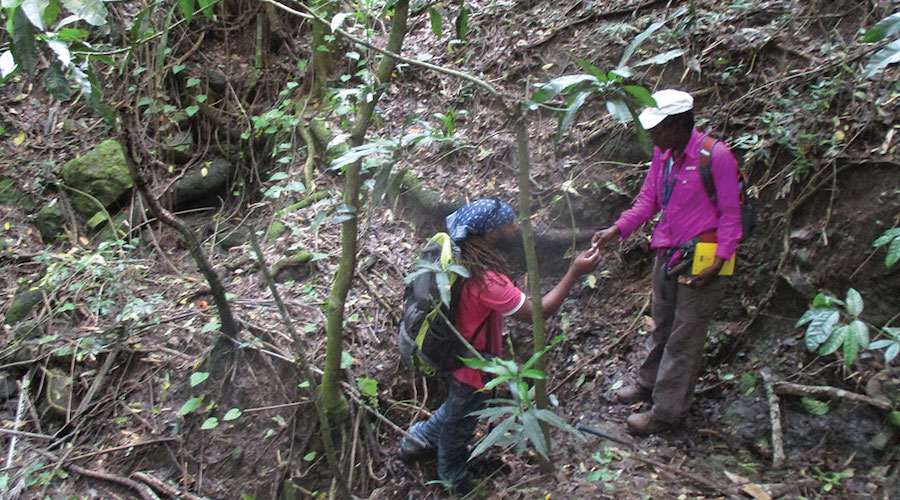
Personnel in the field at Carube Copper’s Main Ridge gold project in Jamaica.Photo by Carube Copper.
Led by president and CEO Stephen Hughes, Toronto-based Carube Copper (TSXV: CUC) is focused on exploring and developing copper and gold projects in Jamaica and Canada.
In Jamaica, Carube holds full interest in 11 licenses totalling 535 sq. km, while in Canada, it holds full interest in three porphyry copper-gold-molybdenum properties totalling 492 sq. km, within the Tertiary-aged Cascade magmatic arc of southwestern British Columbia.
In mid-March, Carube reported that it had received 500,000 shares of newly listed, Calgary-based Tocvan Ventures (CSE: TOC) and been paid $25,000, pursuant to an option agreement struck in May 2018, whereby Tocvan has an option to acquire up to an 80% interest in Carube’s Rogers Creek Property, which covers 212 sq. km in the Lillooet mining district in the Cascade magmatic arc, 90 km northeast of Vancouver.
In January, Carube reported from its ongoing surface exploration program at its Main Ridge project in Jamaica, with assay results from recent soil and rock sampling over the eastern area of the property. Carube says mapping and prospecting in conjunction with a grid-based soil sampling program and follow-up rock channel sampling has found high-grade, copper-silver mineralization along the Rio Minho Valley, located northeast of and parallel to the Bennett gold zone.
Channel sampling highlights include: the Cobre Verde prospect, returning 16 metres of 1.22% copper and 7.8 grams silver per tonne; the Lime Valley prospect, returning 2 metres of 6.07% copper and 19.4 grams silver; and the Trout Hall prospect, returning 6 metres of 2% copper.
COPPER FOX METALS
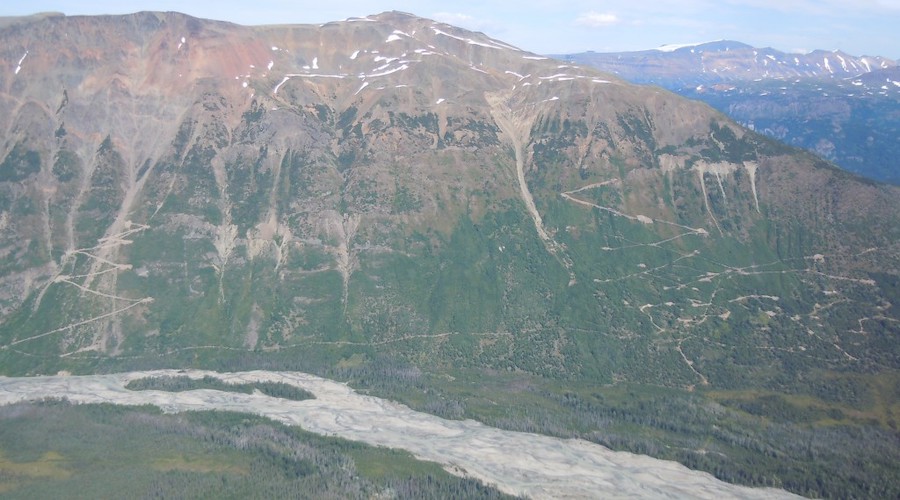
Drill roads on Mt. Lacasse at the Schaft Creek copper property in B.C. in 2011-12. Photo by Copper Fox Metals.
Calgary-based Copper Fox Metals (TSXV: CUU; US-OTC: CPFXF) is focused on exploring and developing copper projects in Canada and the U.S. — most notably its 25% interest in the Schaft Creek joint venture with Teck Resources (TSX: TECK.B; NYSE: TECK) on the Schaft Creek copper-gold-molybdenum-silver project in northwestern B.C., and full ownership of the Van Dyke in-situ-leach, oxide copper project in Miami, Arizona.
In March, the company announced a $1.5-million, non-brokered private placement consisting of up to 13.6 million units at 11¢ per unit. Each unit consists of a share and half a warrant, with each whole warrant entitling the holder to buy another share for 13¢ during the first 12 months, or 15¢ during the second 12-month period.
In its first-quarter results, Copper Fox said that the multi-disciplinary team established by the Schaft Creek joint venture in 2018 to describe and characterize several development scenarios for the Schaft Creek deposit will continue its work in 2019. The joint venture plans to strengthen the project management team to complete more scoping-level engineering and design work based on the 2018 program to assess opportunities associated with a range of development scenarios, the focus of which is to improve financial returns over those outlined in a 2013 feasibility study.
The company adds that “positive exploration results from the Mineral Mountain and Van Dyke projects strongly suggest that additional exploration work is warranted on both projects.”
COPPER MOUNTAIN MINING
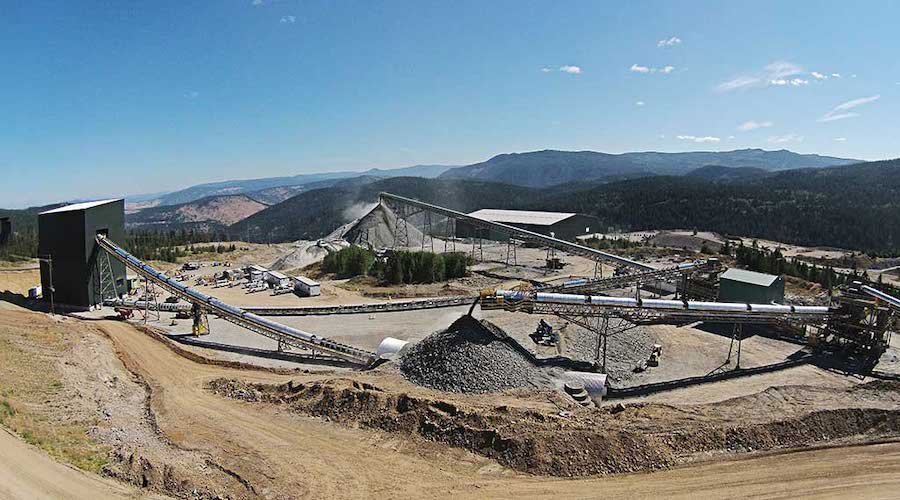
The crusher circuit in operation at Copper Mountain Mining’s namesake copper mine in British Columbia. Photo by Copper Mountain Mining.
Copper Mountain Mining (TSX: CMMC; US-OTC: CPPMF) is a single-asset copper producer, with its Copper Mountain mine in southern B.C., which produces 90 million lb. copper equivalent per year.
The Vancouver-based company says that with a 5,000-tonne mill expansion to 45,000 tonnes per day and integration of the New Ingerbelle pit, the Copper Mountain mine is expected to have a 26-year mine life and produce an average of 116 million lb. copper equivalent per year.
The rosier numbers come from a new integrated mine plan unveiled February 2019, which was highlighted by a 102% increase in reserves; a 27% increase in anticipated average annual copper equivalent production to 116 million lb.; a 12-year mine-life extension; and a decrease in C1 cash costs to US$1.87 per lb. produced, compared to numbers filed in November 2018.
The new mine plan is a phased approach, with the first phase being the plant expansion, which would require installing a third ball mill and could be completed as early as 2020 and would cost US$25 million. The second phase would be developing New Ingerbelle, which requires capital of US$23 million.
The after-tax net present value of the new plan is US$619 million at an 8% discount rate.
Meanwhile, Copper Mountain Mining says it has a “robust development organic growth pipeline” that includes the permitted, development-ready Eva copper project in Queensland, Australia, which could contribute another 100 million lb. copper equivalent per year, when in production.
GT GOLD
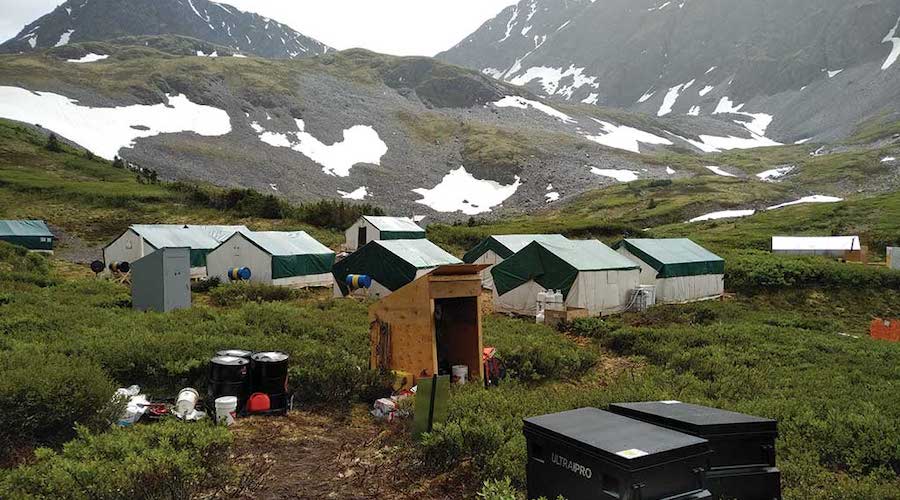
The camp at GT Gold’s Saddle gold property in northwest British Columbia. Photo by GT Gold.
Led by president and CEO Steve Burleton and vice-president of exploration Charles J. Greig, junior explorer GT Gold (TSXV: GTT; US-OTC: GTGDF) says it is “advancing the most important new gold-copper discoveries in the northern part of British Columbia’s rich Golden Triangle since the discovery of the nearby Red Chris deposit,” with GT Gold’s discoveries collectively held within the wholly owned, 432 sq. km Tatogga gold property.
The Vancouver-based firm describes the Saddle discovery area, located up a valley just 10 km off Highway 37, as a combination of shallow, bulk-tonnage-style gold at surface, and, just below, deep, high-grade underground-style gold at Saddle South, with a massive new copper-gold-silver porphyry system “right next door that is reminiscent of Red Chris.”
GT Gold has been developing the various grassroots Saddle gold-silver-copper prospects since 2011, and in March said it was still planning its 2019 drilling campaign at Tatogga.
In tabling its final results from 2018, GT Gold said that the program “was successful in extending the high-grade epithermal system discovered in 2017 along strike by several hundred metres, and to a similar depth beneath largely covered and untested areas east and west of Saddle Ridge. High-grade intercepts within numerous broadly mineralized intervals continue to increase the extent of the Saddle South mineralized system.”
PERUVIAN METALS
Toronto-based junior Peruvian Metals (TSXV: PER; US-OTC: DUVNF) changed its name from Duran Ventures in September 2018 to better reflect its focus on completing the final stages of commissioning its mineral processing plant in northern Peru and developing its exploration property portfolio in the country.
Directors and officers of the company include: Jeffrey J. Reeder, chairman and CEO; John P. Thompson, director; Steve Brunelle, director; William R. (Rick) Brown, director; Oscar Franciso Pezo Camacho, director; and Daniel Hamilton, chief financial officer.
Peruvian Metals owns an 80% interest in the Aguila Norte process plant, located just off the Pan American highway near the large city of Trujillo in northern Peru.
The company says “abundant small-scale mining activity occurs in northern Peru, but there are very few independent processing facilities available. The Aguila Norte mineral processing plant hosts crushing, milling, gravity separation and flotation circuits, with an initial throughput capacity of 100 tonnes per day. Peruvian Metals anticipates feeding high-grade polymetallic and precious-metal sulphide minerals through the process plant to deliver high-value concentrates available for sale to the Peruvian metal trading market.”
Peruvian Metals then expects to fund plant expansion via internal cash flow from the plant.
The junior’s exploration properties in the country include the Mamanina porphyry copper project; the Panteria copper-molybdenum-gold project; and the Minasnioc epithermal gold-silver project.
SEABRIDGE GOLD
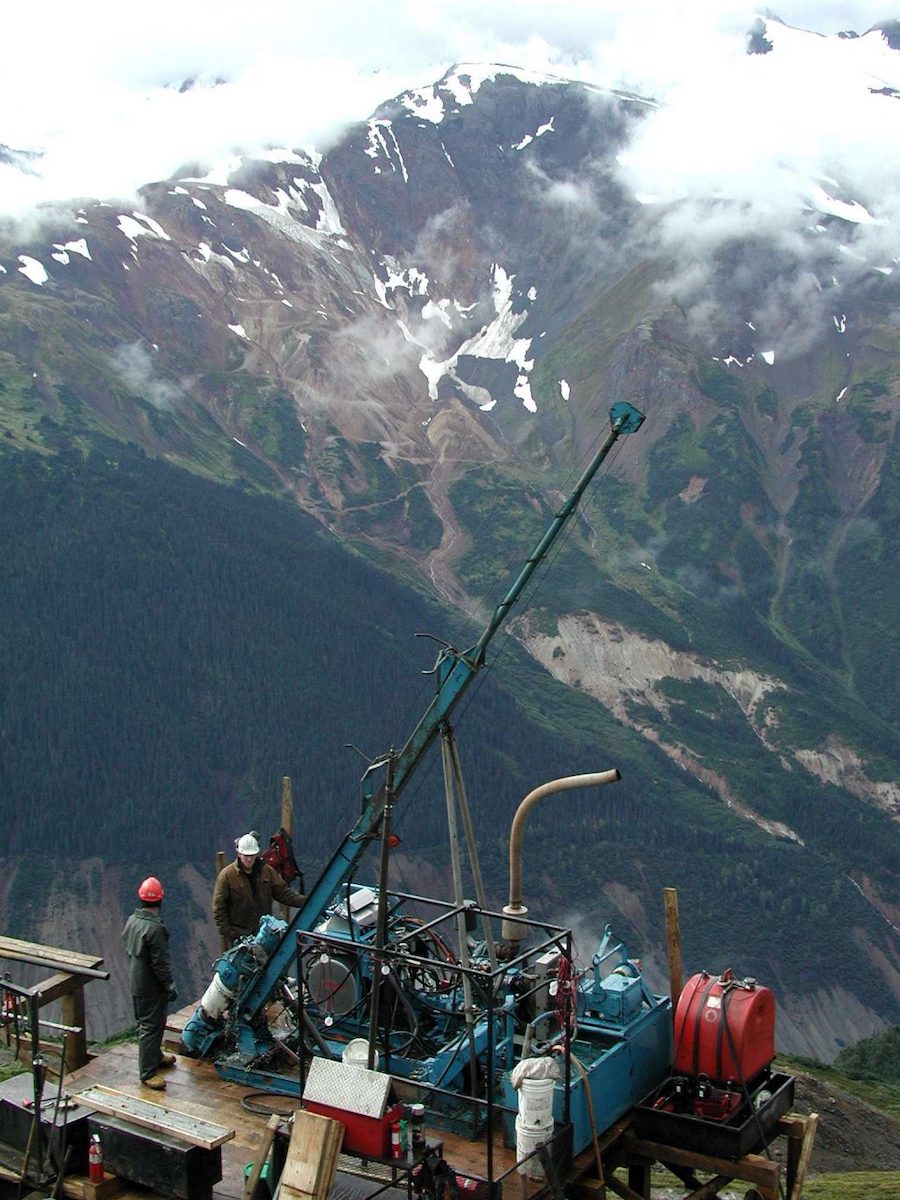
Drilling at Seabridge Gold’s KSM gold-copper project in B.C. in 2017. Photo by Seabridge Gold.
Seabridge Gold (TSX: SEA; NYSE: SA) continues its work advancing some of North America’s largest gold-copper deposits, most notably the KSM and Iskut properties near Stewart, B.C.., and the Courageous Lake gold project in the Northwest Territories.
In March, Seabridge substantially boosted the resource estimate for the Iron Cap deposit, which is one of four large gold-copper porphyry deposits within its wholly owned KSM project. The new resource figure incorporates all previous drilling, plus 20,341 metres of diamond core drilling completed in 18 holes during 2018.
Iron Cap’s indicated resources now stand at 423 million tonnes grading 0.41 gram gold per tonne, 0.22% copper, 4.6 grams silver per tonne and 41 parts per million molybdenum, while inferred resources have swelled to 1.9 billion tonnes at 0.45 gram gold, 0.30% copper, 2.6 grams silver and 30 parts per million molybdenum.
Seabridge says the new resource estimate has “achieved the targeted size and grade, which are likely to warrant moving the Iron Cap deposit ahead of the Kerr and Sulphurets deposits in the project’s mine plan.
Chairman and CEO Rudi Fronk said that Seabridge’s “exploration success at Iron Cap over the past two years gives us greater flexibility to optimize project economics. Iron Cap is closer to infrastructure than Kerr and Sulphurets, and its development could be faster and less costly. Within the 1.9 billion tonnes of inferred resource, there exist significantly higher-grade underground cave opportunities with substantial tonnage. Iron Cap clearly has the size and grade to justify early inclusion in the mining sequence. From our point of view, this is mission accomplished.”
Fronk also said these resource additions once again have met the junior’s annual corporate objective of increasing gold ownership on a per-share basis, noting that Seabridge added 460,000 oz. indicated gold resources and 7.5 million oz. inferred gold resources from our 2018 program.
This story first appeared in The Northern Miner on April 6, 2019.